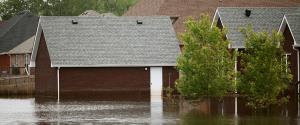Be on the Lookout for Flooding

Be on the Lookout for Flooding
The official start of spring is almost here. While you may be excited to watch the first signs of spring bloom, you also need to be on the lookout for other not so desirable springtime weather—like melting snow, heavy rain and potential flooding.
Did you know that one in four homeowners will experience flooding in their homes over the course of their lifetime? As a result of the warmer weather and heavy showers that spring brings, the thawing ground is unable to absorb excess water. This results in the overflow of streams, rivers, lakes and even ice dams.
While you can’t prevent floods from occurring, you can reduce your risk. Here are a few simple steps that can help you get smart about floods.
- Know your action plan: The time to prepare for a flood is before the first signs of flooding even occur. Talk with your family to devise a flood evacuation plan and put together an emergency kit to grab in a flash should the need arise. In addition to preparing your family for a flood, you must also prepare your home. If you know a flood is likely to occur, bring outdoor furniture inside and move any important indoor items to the highest possible floor. You should also disconnect any and all electrical appliances in your home—and remember not to touch electrical equipment if you are wet or standing in water. For additional information on flood preparedness, visit gov/floods.
- Know your coverage: Only flood insurance covers flood damage. However, most standard homeowner policies do not cover this, so make sure you have purchased the proper flood insurance for your home before a flood occurs. It typically takes 30 or more days for a flood insurance policy to go into effect, so be sure to consider this period of “no coverage” when purchasing your policy. Luckily, flood insurance is extremely cost-effective—an average flood policy costs around just $600 a year, which makes purchasing flood insurance for your home an affordable—and needed—luxury.
- Know your follow-up plan: After floodwater has been removed from your home, check for damage - looking for visible structural damage or damage to water, gas, electric and sewer lines. If you suspect damage to your home, contact the authorities immediately. Next, remove any wet contents from your home, such as wet carpeting, furniture, bedding and clothing. Items holding moisture can develop mold within 24 to 48 hours, so it’s important to clean and disinfect all items touched by floodwater as soon as possible.
- Arm your home with the proper tools: Be prepared for flooding with a Sump Pump from A.Y. McDonald. Our DuraMac Sump Pumps feature tough construction and continuous duty motors for quality, dependable pumping—even in the toughest of situations.

